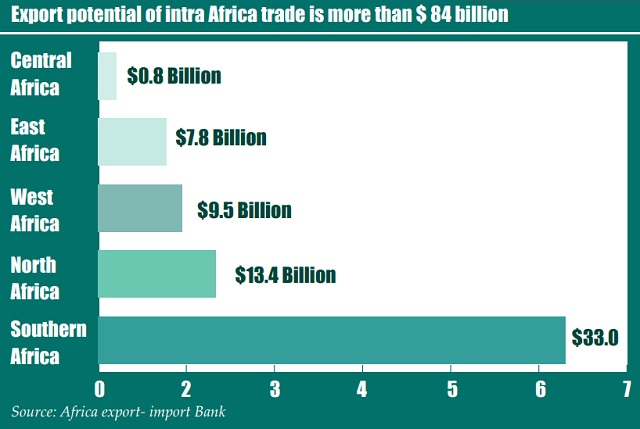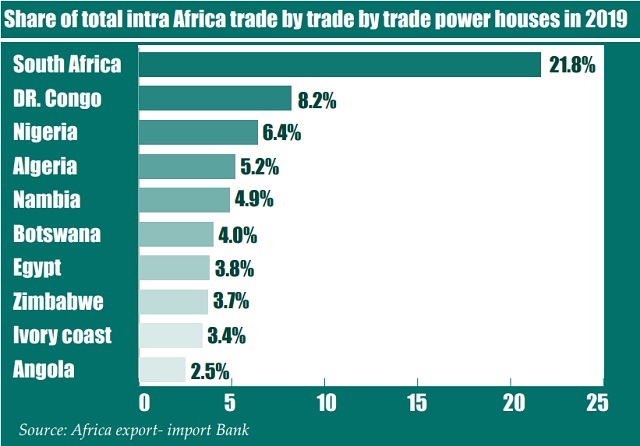
Intra-trade boost
But recent efforts to boost intra-continental trade are already paying off. While global trade declined by 2.89% in 2019 partly due to tensions between the U.S. and China, Africa’s total merchandise trade contracted by only 0.13% to about $1 trillion, according to Afreximbank data. Internal trade fell to 14.5% of the total in Africa, compared with 15% in 2018.
But in total value comparison, internal shipments account for 52% of total trade in Asia and 72% in Europe, according to Afreximbank data. In 2017, intra-African exports were 16.6% of total exports, compared with 68% in Europe, and 59% in Asia.
AfCFTA has the potential to increase intra-African trade by over 50%, according to the UN Economic Commission for Africa, while the World Bank suggests the agreement could mean an added $76 billion in income for the rest of the world.
Most of the untapped gains would come from southern Africa, from sectors like mineral commodities, machinery, food products, vehicles and parts, plastics and rubber that are internationally competitive and exportable to other African markets.
North Africa also has great intra-Africa export potential because of the region’s competiveness in industrial products and manufactured goods that are the leading drivers of cross-border formal trade, according to Afrixim Bank.
Nigeria agreed late to ratify the deal but officials from the continent’s biggest economy say they aims to exploit it to double export trade to $50 billion within a decade.
What to expect
Experts expect implementation of the deal will suffer teething problems as it comes in effect at a time when the COVID-19 pandemic is causing global economic destruction. Its implementation could also be impacted by lack of modern and efficient infrastructure like road and rail links, unclear information about processes, and commonplace red tape and protectionist tendencies of some member states. Other challenges could be political instability and widespread corruption.
So far, 41 of the zone’s 54 member states have submitted tariff reduction schedules.
Members must phase out 90 percent of tariff lines – over five years for more advanced economies or 10 years for less developed nations. Another 7% considered sensitive will get more time, while 3% will be allowed to be placed on an exclusion list.
Efforts to implement the deal will also likely face resistance from countries’ domestic interest groups. Fears of losing out to more competitive neighbours initially made some countries, including Nigeria, skeptical.
 The next stage, according to some experts, is for African governments to a unified means of payment, a project that African central banks are working on. A continent wide currency value would enable Africa to compete more favourably with the rest of the world.
The next stage, according to some experts, is for African governments to a unified means of payment, a project that African central banks are working on. A continent wide currency value would enable Africa to compete more favourably with the rest of the world.
According to many experts, investment in industrialisation will also be key to ensure that “Made in Africa” brands that AfCFTA hopes to market within Africa will be successful. . It is important to note that most African countries trade finished goods amongst each other, but due to the low industrialisation levels in Africa, they still have to depend on developed markets for supply of these goods.
AfCFTA promises to expand the intra-African trade from the traditional regional economic communities – where trade between African countries is currently domiciled – to the continental level. This will help diversify African economies and promote continental trade integration that could see an increase in containerised trade and port traffic volumes.
****
 The Independent Uganda: You get the Truth we Pay the Price
The Independent Uganda: You get the Truth we Pay the Price


